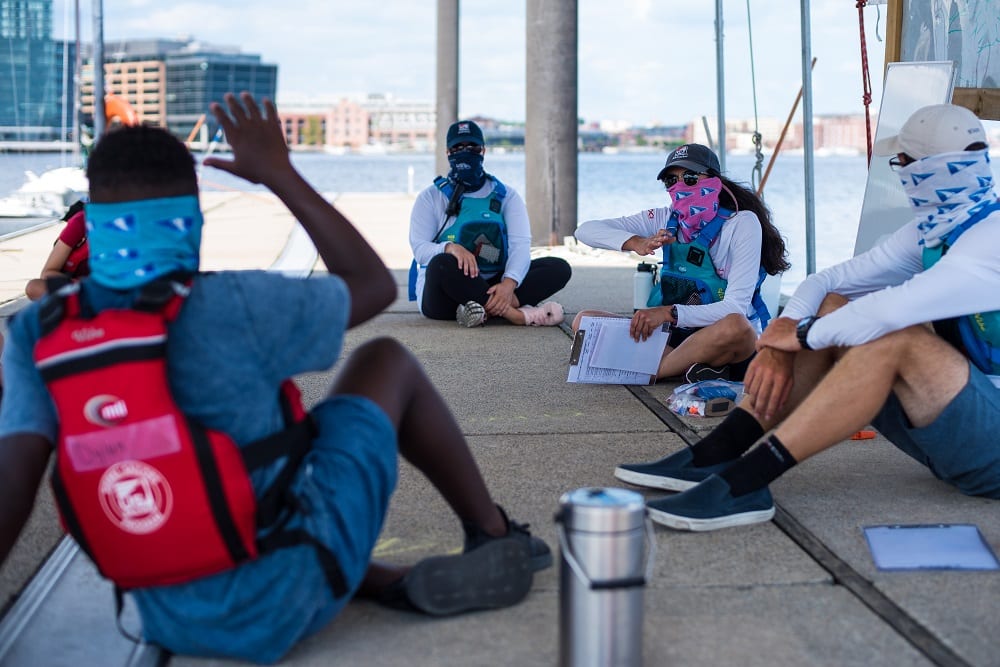
By Janel Zarkowsky, Siebel Coach for the Mid-Atlantic Region
Every savvy sailor knows to check the wind, current, tide, and the radar before they head out on to the water. When you come to Baltimore’s Inner Harbor, where one of our Mid-Atlantic Siebel programs runs at The Downtown Sailing Center, the savvy sailor adds one more forecast to the list: the water quality.
Baltimore City and the Inner Harbor has long held a negative stigma around the Patapsco River that runs through the center of the city. It’s always lovely to sit next to the water, but never to touch! The Downtown Sailing Center (DSC) has had great success teaching learn-to-sail programs and retaining members by using boats that can’t tip over and keep its passengers a comfortable distance from the water. It was an eye-opener that the DSC was so excited to join the Siebel Sailors Program, knowing that fleet of boats we use are dinghies, can be unstable to novice sailors, and definitely tip over!
Being sensitive to the persistent concern of water quality has been a challenge as sailing coach. Some of the first lessons for novice sailors are water comfortability with a swim check and boat safety with a capsize recovery demonstration; however, we could not and would not do those in the Patapsco River. With some creative lesson planning, passionate support from the DSC staff, and masthead pool noodles, the kiddos are sailing solo in a capsize-able boats weekly!
As I reflect on months of successful lessons, I also think back to one of the first days of summer at the DSC when six Fevas were being delivered and summer staff training was underway. I had ten young volunteers to help me untie, unstack, unpack, and launch six new RS Feva XLs. After getting all the boats ready in the gravel parking lot, we rolled them towards the water’s edge. The path for the dollies weaved in-between two keelboat trailers and down a short, but steep gravel hill to the beach. We were going to launch the boats off the gravel beach and sail them around to the far B Dock ramp to stay for the summer and fall seasons. Everyone was so excited to sail the brand new white and neon boats!
As the first boat rolled into position to launch, I realized that summer staff have been training on keelboats and have never seen an RS Feva XL before. I walked waist deep into the water to make sure the rudder was down all the way and the tiller wasn’t tangled in the mainsheet. When I looked up at the summer staff still on the beach, their jaws dropped and they were staring at me.
One summer staff exclaimed to me, “You just ruined your Nikes?!”
I laughed and replied, “It’s ok, I’ll just throw them in washing machine tonight.”
The summer staff looked between themselves thinking, “Is this lady crazy…”
I kept working my way around the first boat to set it up correctly and called the first sailor to hop in so I could give them a push in the right direction.
He said, “Well I’m not ruining my shoes,” and starting to untie and take off his Nikes.
I got some pinched lips when I said “No-no, everyone needs to be wearing closed-toe shoes when they sail around.”
So as all coaches learn to do, I adapted! I told them my shoes were already ruined so I’ll stay in the water. I would hold each boat on the beach for each sailor to step in, and then push them off on their quick sail to B Dock.
I laughed when I told the story to Rena Kazmierski, Sailing Education Manager at the DSC. She told me, “You don’t touch the water in Baltimore. And you definitely don’t let your shoes touch the water!” I didn’t fully think about how much of a taboo it was to stay out of the water for the water quality reasons, but also how lucky I was to have multiple pairs of nice shoes to the point that I didn’t have to worry if one pair got dirty. I think that’s something we can all remember as coaches and instructors across the country continue to welcome new youth into sailing programs. Learn the historical context of the location you’re in and how that manifests in your sailor’s experience. It was a live and learn experience for me!
Learn more about the Siebel Sailors Program.
Follow Janel Zarkowsky on Instagram at @siebelcoach_janel to stay tuned with Siebel programming in the Mid-Atlantic region.
